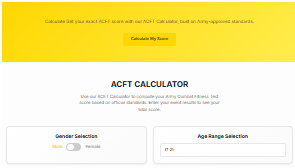ACFT Score Chart: The Complete Guide to Mastering the Army Combat Fitness Test
The ACFT Score Chart is the foundation of physical readiness for every U.S. Army soldier. Whether you’re preparing for basic training, active duty, or simply want to understand how the Army evaluates fitness, the ACFT (Army Combat Fitness Test) is the ultimate measure of strength, endurance, and resilience.
Understanding the score chart not only helps you track your progress but also shows where you need to improve. In this complete guide, we’ll break down every event, scoring system, training strategy, and recent update — giving you everything you need to conquer the ACFT.
What Is the ACFT?
The Army Combat Fitness Test (ACFT) is the official fitness assessment designed to measure a soldier’s ability to perform physically demanding tasks in combat situations. It replaced the old Army Physical Fitness Test (APFT) in 2020 to provide a more realistic and comprehensive evaluation of military fitness.
Unlike the old test that focused on push-ups, sit-ups, and running, the ACFT includes six challenging events that test multiple aspects of performance — from muscular strength to cardiovascular endurance.
Why the ACFT Was Created
The U.S. Army designed the ACFT to better reflect the physical challenges soldiers face during missions. Lifting heavy loads, sprinting under pressure, and maintaining endurance over long periods are all real-world combat skills.
The ACFT encourages soldiers to develop balanced, functional fitness — not just the ability to run fast or do push-ups. It focuses on total-body strength, explosive movement, coordination, and stamina.
ACFT Events Overview
The test includes six individual events. Each event targets different muscle groups and fitness categories. Together, they create a complete assessment of physical readiness.
-
3-Repetition Maximum Deadlift (MDL)
Measures lower-body and grip strength. Soldiers lift a hex bar three times using proper form. -
Standing Power Throw (SPT)
Tests upper-body power. Soldiers throw a 10-pound medicine ball backward over their head for distance. -
Hand-Release Push-Ups (HRP)
Builds endurance and upper-body stability. Soldiers lower their chest to the ground, release their hands, and press back up. -
Sprint-Drag-Carry (SDC)
A full-body agility and endurance challenge that includes sprinting, dragging a sled, lateral shuffling, and carrying kettlebells. -
Plank (or Leg Tuck)
Evaluates core strength and stability. Soldiers hold a plank position for as long as possible or perform leg tucks. -
Two-Mile Run (2MR)
Tests cardiovascular endurance. The run must be completed on a flat surface in the shortest time possible.
Each event is worth up to 100 points, making 600 the highest possible total score.
ACFT Score Chart Breakdown
Here’s a simplified look at how the ACFT Score Chart works for each event.
| Event | Maximum Points (100) | Minimum Standard (60) |
|---|---|---|
| 3RM Deadlift | 340 lbs | 140 lbs |
| Standing Power Throw | 12.6 m | 4.5 m |
| Hand-Release Push-Ups | 60 reps | 10 reps |
| Sprint-Drag-Carry | 1:33 min | 3:00 min |
| Plank | 3:30 min | 2:00 min |
| Two-Mile Run | 13:30 min | 21:00 min |
To pass the ACFT, soldiers must score at least 60 points in each event, totaling a minimum of 360 points overall. A perfect score of 600 represents elite physical performance.
How ACFT Scoring Works
The ACFT uses a points-based system to convert your raw results into scores. Each performance benchmark corresponds to a specific point value.
For example:
-
If you deadlift 180 lbs, you might earn around 70 points.
-
If you complete the 2-mile run in 15 minutes, that could be worth about 80 points.
-
A 3-minute plank earns roughly 90 points.
The score chart also adjusts slightly for gender and age, ensuring fair standards for all soldiers.
Performance Categories
The Army recognizes three performance categories based on total scores:
-
Gold (540–600 points): Exceptional fitness level and elite readiness.
-
Silver (480–539 points): Above-average performance.
-
Bronze (360–479 points): Minimum passing standard.
Falling below 360 points or failing any single event results in a “No Go” status, requiring retesting.
Why the ACFT Score Chart Matters
Your ACFT Score Chart isn’t just about numbers — it’s a reflection of your readiness and discipline. It affects your career in several ways:
-
Promotion eligibility — higher scores strengthen promotion packets.
-
Job placement — certain roles (MOS) require specific physical standards.
-
Retention and evaluations — consistent passing scores show reliability and readiness.
It’s also a motivational tool. Tracking your progress through the score chart helps you set realistic goals and see how your training pays off over time.
ACFT 3.0 and New Updates
The latest version of the test, ACFT 3.0, introduced several important updates to make scoring more fair and inclusive:
-
Gender-neutral scoring system.
-
Plank exercise replaces the leg tuck as a core test option.
-
Adjusted scoring standards for combat and non-combat MOSs.
-
Clearer performance benchmarks for different age groups.
These changes ensure that all soldiers are evaluated fairly, while maintaining the high physical standards required for service.
How to Calculate Your ACFT Score
-
Record your raw results for each of the six events.
-
Use the official ACFT Score Chart to convert those results into points.
-
Add all six scores to determine your total out of 600.
-
Compare your total score to the performance categories (Gold, Silver, or Bronze).
For quick results, many soldiers now use online ACFT calculators, which automatically compute scores based on entered results.
ACFT Score Chart by Age and Gender
The Army recognizes that physical ability changes over time, so score requirements adjust with age. Here’s a quick summary:
-
Ages 17–21: Highest performance expectations.
-
Ages 22–26: Slightly adjusted minimums.
-
Ages 27–36: Standards moderate further.
-
Ages 37–46+: Gradual reduction in minimums to maintain fairness.
The goal is not to lower standards but to ensure that every soldier is evaluated relative to their age group and capability.
Training Tips to Improve Your ACFT Score
Improving your ACFT Score Chart results requires a smart, consistent training approach. Here are practical strategies that work for soldiers at all fitness levels:
1. Strength Training for the Deadlift and SDC
Focus on compound lifts like squats, deadlifts, and cleans. These build the core and leg strength needed for both lifting and dragging events.
2. Power and Explosiveness for the SPT
Add exercises like medicine ball slams, kettlebell swings, and plyometrics to improve throwing distance and upper-body power.
3. Endurance for the 2-Mile Run
Include interval training, hill sprints, and steady-state runs in your routine. Improving pace consistency is key to cutting seconds off your time.
4. Core Stability for the Plank
Train your abs and back with planks, leg raises, and rotational movements. A strong core improves nearly every ACFT event.
5. Recovery and Mobility
Stretch regularly, focus on proper nutrition, and allow muscle recovery days. Overtraining can reduce performance and increase injury risk.
6. Simulate Test Conditions
Train under realistic ACFT conditions — same event order, rest intervals, and environment. This helps your body and mind prepare for test day.
Common Mistakes to Avoid
-
Skipping warm-ups: Increases injury risk and lowers performance.
-
Poor form: Especially during deadlifts and push-ups, this can result in disqualification.
-
Neglecting weak areas: Focusing only on one or two events won’t yield a strong overall score.
-
Ignoring recovery: Fatigue can drastically reduce your total score.
Consistency and smart recovery are just as important as hard training.
A printable ACFT Score Chart is a handy resource for weekly training sessions. You can:
-
Record test results manually.
-
Compare scores across weeks.
-
Identify improvement areas.
Keeping a chart in your workout log or gym bag makes tracking simple and motivating.



Leave a Reply